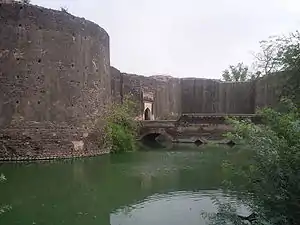Deeg
Deeg is a town and a municipality in Bharatpur district in the state of Rajasthan, India. It is situated 32 kilometres (20 mi) north of Bharatpur and 98 kilometres (61 mi) north of Agra.
Deeg | |
|---|---|
City | |
 Deeg Palace or Jal Mahal Deeg | |
 Deeg Location in Rajasthan, India | |
| Coordinates: 27.47°N 77.33°E | |
| Country | |
| State | Rajasthan |
| District | Bharatpur |
| Government | |
| • Type | Congress |
| Elevation | 174 m (571 ft) |
| Population (2011) | |
| • Total | 44,999 |
| Languages | |
| • Official | Hindi |
| Time zone | UTC+5:30 (IST) |

In Hindu mythology, Deeg was situated along the parikrama path of Krishna, which started at Goverdhan, 14 kilometres (8.7 mi) from Deeg. Some people identify it as the ancient town of "Dirgha" or "Dirghapur" mentioned in the epic Skanda Purana. Deeg was the first capital of the Sinsinwar Hindu Jat state of Bharatpur, when Maharaja Badan Singh was proclaimed its ruler in 1722. In 1730, Maharaja Suraj Mal erected the strong fortress of Deeg. After Suraj Mal moved the capital to Bharatpur, Deeg became the second capital of the rulers of Bharatpur princely state. It is known for its number of forts, palaces, gardens and fountains.
Geography
Deeg is located at 27.47°N 77.33°E.[1] It has an average elevation of 174 m (571 ft).
History
It is an ancient town. It finds mention in Skanda Purana as "Dirgha" or "Dirghapura". Deeg was the first capital of the Jat state of Bharatpur, when Badan Singh was proclaimed its ruler in 1722. In 1730, the Maharaja Suraj Mal erected the strong fortress of Deeg. After Suraj Mal moved the capital to Bharatpur, Deeg became the second capital of the rulers of Bharatpur princely state. It is known for its number of forts, palaces, gardens and fountains.
Badan Singh ( 1722–1756 AD) after assuming the throne consolidated the headship of the tribe and thereby became the virtual founder of the Jat house at Bharatpur. The credit of commencing the urbanization of Deeg also goes to him. It was he who selected this spot as the headquarters of his newly established Jat kingdom.
After the Third Battle of Panipat between the Marathas and the pan-Islamic coalition led by Ahmad Shah Durrani for control over North India, Shamsher Bahadur (the son of Baji Rao I and Mastani) died at Deeg around the 20 January, 1761, of wounds sustained at the Battle of Panipat.
During 1804, both the Battle of Deeg and the Siege of Deeg brought the British East India Company into conflict with Bharatpur's Jat rulers and their Maratha allies for control of the area.
Deeg in films
The 1972 movie by Conrad Rooks, Siddhartha, based on Herman Hesse's novel, was shot in Deeg. Additional scenes in the film were shot in Keoladeo Ghana Sanctuary, Bharatpur.
Fairs
Deeg is known for the three-day fair held in the month of September, when the forts of Deeg are brought to liveliness. Recently from 2019 in the month of October named Deeg Festival was organized by the tourism's minister and MLA Shree Maharaja Vishvendra Singh ji and tourism department of Rajasthan. In the month of March a great BRIJ MAHOTSAV during Holi festival also celebrate in City Deeg.
Architecture
The palace complex together with its water gardens was a summer retreat for the maharajas of Bharatpur. The layout comprises several palaces called bhawans, interwoven within series of charbaghs and water gardens. The major Bhawans are Gopal Bhawan, Divan I Khas or the Kishan Bhawan, Wrestling palace or Nand Bhawan, Keshav Bhawan, Hardev Bhawan, Suraj Bhawan and symmetrically arranged twin pavilions of Sawan & Bhadon.[2]
Demographics
As of 2011 India census,[3] Deeg had a population of 40,999. Males constitute 54% of the population and females 46%. Deeg has an average literacy rate of 61%, higher than the national average of 59.5%: male literacy is 71% and, female literacy is 49%. In Deeg, 17% of the population is under 6 years of age.
How to reach
Can be reached from Agra, Mathura, Alwar or Bharatpur. Regular Buses are available from Jaipur, Bharatpur, Alwar, Mathura and New Delhi. trains are available from Alwar and Mathura. Deeg railway station lies on the Mathura-Alwar railway line that caters mainly to freight trains and also slow train service from Jaipur.
The nearest Airport is Delhi and can be reach in 3-4 hours.
Attractions
- Deeg Palace with its 900 fountains, which operate twice a year during the Avamasaya festivals in February and September. The Deeg Palace museum is closed on Fridays. Fort of Deeg is known for its security and force.
- Lakshman Temple (Lakshman Mandir), situated as the prime location in Deeg. Temple is quite older and big enough, which also represents a market area from Mahesh medicals to Sunil Medicals (well known and reputed shops).
References
| Wikimedia Commons has media related to Deeg. |
- Falling Rain Genomics, Inc - Deeg
- Chugh, Bharat; Chugh, Shalini (2014). Deeg Palace: Its Romance & Wonder. Niyogi Books, India. ISBN 9789383098538.
- "Census of India 2001: Data from the 2001 Census, including cities, villages and towns (Provisional)". Census Commission of India. Archived from the original on 16 June 2004. Retrieved 1 November 2008.
